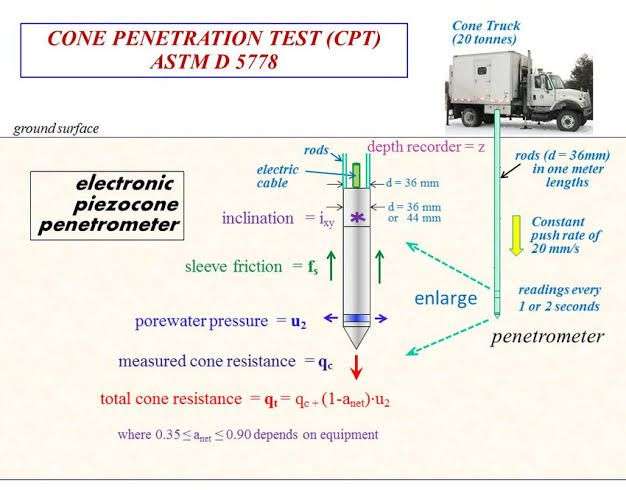The Cone Penetration Test (CPT) is a widely used in-situ testing method in geotechnical engineering for determining the geotechnical properties of soils. The CPT provides continuous or semi-continuous data on soil stratigraphy and properties such as soil type, relative density, shear strength, and other parameters relevant to foundation design and soil behavior analysis.

CPT Procedure
- Equipment Setup: The test uses a cone penetrometer, which is a cylindrical rod with a conical tip and friction sleeve. The standard cone has a tip angle of 60 degrees and a base area of 10 cm². The penetrometer is mounted on a rig (often truck-mounted or mobile) equipped with a hydraulic pushing system to advance the cone into the ground.
- Penetration Process: The cone penetrometer is pushed into the ground at a constant rate, typically 2 cm/s (± 20%).During penetration, measurements are taken continuously or at regular intervals for parameters such as tip resistance (qc), sleeve friction (fs), and pore water pressure (u).
- Data Acquisition:
- Tip Resistance (qc): The resistance offered by soil to the penetration of the cone tip, measured in MPa. It indicates the soil’s strength and bearing capacity.
- Sleeve Friction (fs): The frictional resistance along the cylindrical surface of the penetrometer sleeve, measured in kPa. It helps in identifying soil type and stratigraphy.
- Pore Water Pressure (u): Measured using a piezocone (CPTu), which includes a pore pressure transducer. Pore pressure data is critical for understanding soil behavior especially in saturated and fine-grained soils.
- Interpretation of Results:
- The acquired data is used to generate profiles of tip resistance, sleeve friction, and pore water pressure with depth.
- These profiles are interpreted to identify soil layers, determine soil type, and estimate geotechnical properties.
Uses of CPT Data
- Soil Classification:
- CPT data is used to classify soils based on empirical correlations. Soil behavior type (SBT) charts, developed from CPT data, help in distinguishing between sands, silts, clays, and mixtures.
- Estimation of Geotechnical Properties:
- Relative Density and Compaction: For sandy soils, the relative density and degree of compaction can be estimated.
- Shear Strength: Correlations between CPT tip resistance and undrained shear strength are used for clays and silts.
- Bearing Capacity: The CPT provides direct measurements that can be used to estimate the bearing capacity of foundations.
- Settlement Prediction: The data helps in predicting settlement behavior of soils under loads.
- Soil Stratigraphy:
- Continuous profiles obtained from CPT are invaluable for identifying soil layers and detecting interfaces between different soil types.
- Liquefaction Potential:
- In seismic regions, CPT data is used to assess the susceptibility of sandy soils to liquefaction during earthquakes.
Advantages of CPT
- Continuous Data: Provides continuous profiles of soil properties with depth, offering a detailed view of subsurface conditions.
- Speed and Efficiency: Quick to perform, providing immediate results.
- Accuracy: Offers reliable and reproducible data, with less operator dependency compared to some other methods.
- Minimal Disturbance: Causes minimal disturbance to the soil, preserving the in-situ state more effectively than other tests.
Limitations of CPT
- Limited to Certain Soil Types: CPT is less effective in very hard or dense soils and cannot penetrate gravels or rock.
- Initial Cost: Requires specialized equipment, which can be costly.
- Interpretation Complexity: Data interpretation requires expertise and can be complex, particularly in layered or mixed soil conditions.
- Pore Pressure Dissipation: In low permeability soils, pore pressure dissipation tests can take significant time, potentially delaying results.
Conclusion
The Cone Penetration Test (CPT) is a powerful tool in geotechnical site investigations, providing detailed and continuous profiles of soil properties. Its ability to rapidly and accurately assess subsurface conditions makes it invaluable for foundation design, soil classification, and assessing geotechnical risks. Despite some limitations, the CPT’s advantages in speed, efficiency, and data quality ensure its widespread use in geotechnical engineering. Proper interpretation of CPT results, combined with other site investigation methods, leads to a comprehensive understanding of ground conditions and supports effective geotechnical design.
Leave a comment